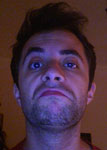Design saved me
When I started doing design, I really didn’t know it was “design”.
I still remember that time - it was four years ago - when I left the Informatics Engineering study degree at Politecnico, and for the first time in my life I felt lost, with a lot of time on hand and nothing to do with it.
But at that time something magical happened: the same day I left the Engineering department I randomly found a magazine in a store called “Computer Arts”, which immediately attracted my attention.
The images I saw inside fascinated me at the point that I started to wonder if I would also have been able to do that kind of stuff.
Then I started doing graphical experiments with Photoshop, an activity which helped me to channel my frustration and gain new skills. Since then I began exploring the design world using the web as a resource for inspiration and knowledge, each time learning on my own how to use the specific tools I needed to accomplish my projects. If you wonder why I’m telling this to you, here is the answer: this is the first and uppermost reason that makes me want to “design things” ; I do it for myself, because it’s a passion.
Three years have passed now and, in order to find other reasons that drive my work as a designer, let’s fast-forward to yesterday evening :
Believe it or not, but for the first time in three years I finally had a theoretical assignment to fulfill, as the former design school I went to was very practical and we had never to speculate on theoretical themes and issues.
They have always been floating in my mind but now, for the first time, I can summarize them on a list of inspirational issues based on the works I’ve been doing over the last few years and on the projects I would like to carry out in the future:
-Inner communication
-How you see yourself
-Music
-Sound + Graphics
-People creativity
-Computers + Nature / Culture + Nature
-Memory + Emotions
-Physical world + Virtual world
-Socialization
-Social Activity
-Play / Ludic Activities
-Knowledge Share
-Politics
-Spaces / Loci
-Democracy
-Computers outside the box
-Networked Objects
-Human Movements + Kinesic
-Remote Communication
- Tools for Curiosity
---------------- 31 January 2008 edit ----------------
- Tools for Curiosity
- Intimate interfaces
- Real-time creativity
- Visual music
- Freedom of expression (GRL)
- Democracy/Open source governance
- Open source devices
- Videogames/Imagination
---------------- END 31 January 2008 edit ----------------
These issues can be linked into four major aims:
- to BRIDGE REAL AND VIRTUAL WORLDS, mixing them together rather than making them fight each other.
- to EXPLORE YOUR INNER SELF thanks to the digital media that have the power to capture and show yourself to yourself.
- to BUILD BEAUTIFUL AND SIGNIFICANT SYSTEM OF RELATIONSHIPS through the collection of data and the successful mapping of them onto new system of values.
- to TRY TO MAKE THE REALITY WE LIVE IN BETTER, allowing people to have access to knowledge and stimulate social activity towards politics and democratic dialectics.
The reading assignments surprised me, as I found in them many suggestions that I had already thought on my own and helped me to focalize on drawing the contours of myself as a designer.
For instance, I almost totally recognize myself in the “Interaction Designer” figure Terry Winegrad wrote about in his essay “From Computing Machinery to Interaction Design”, because I know I have the skill of a graphic designer, programmer, video designer, but I didn’t know how they could fit in just one craft.
Another thing in which I can recognize myself in the lecture submitted is in “The Pillow” by Anthony Dunne, because, until now a design centered approach is the way I designed most of the things I’ve done, which I used to label as “experiments”.
Value fictions are not only important but vital for design ... if design was just user centered it would be totally boring.
I think that we, the people who have the privilege to work with the digital media, must be aware of the power and responsibility that lies in our hands, since we have to master information in the information era.


























